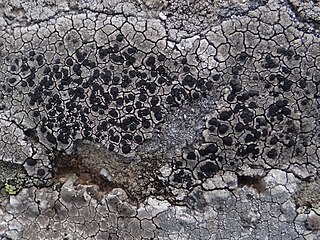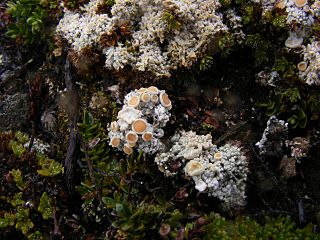
Rhizocarpon geographicum is a species of lichen, which grows on rocks in mountainous areas of low air pollution. Each lichen is a flat patch bordered by a black line of fungal hyphae. These patches grow adjacent to each other, leading to the appearance of a map or a patchwork field.
Geltingia is a fungal genus in the family Helicogoniaceae. It is monotypic, containing the single lichenicolous species Geltingia associata. The genus was circumscribed in 1990 by mycologists Vagn Alstrup and David Leslie Hawksworth. The genus name honours Danish scientist Paul Gelting.

Carbonea is a genus of fungi in the family Lecanoraceae. Most of the species grow on lichens. The genus is widespread, and contains 20 species. Carbonea was originally circumscribed as a subgenus of Lecidea in 1967 before it was promoted to generic status in 1983.

Lecidea atrobrunnea is a crustose lichen in the Lecideaceae family, found in mountains of the continental western United States and Alaska. With other lichen communities, it forms dark vertical drip-like stripings along drainage tracks in the rock faces, resulting in Native Americans giving the name "Face of a Young Woman Stained with Tears" to Half Dome. This combined lichen community appears black from a distance, but brown up close.

Candelariella vitellina is a common and widespread green-yellow to orange-yellow crustose areolate lichen that grows on rock, wood, and bark, all over the world. It grows on non-calcareous rock, wood, and bark.

Lecanora polytropa, commonly known as the granite-speck rim lichen, is a species of saxicolous lichen in the family Parmeliaceae. A small, inconspicuous species that grows in the cracks of rock surfaces, it has a cosmopolitan distribution and has been recorded on all continents, including Antarctica.

Stereocaulon alpinum is a species of fungus belonging to the family Stereocaulaceae. It is similar to Stereocaulon paschale but differs from it in containing cyanobacteria of the genus Nostoc while S. paschale contains cyanobacteria of the genus Stigonema, which have a darker colour than Nostoc.

Carbonea vitellaria is a species of lichenicolous fungus belonging to the family Lecanoraceae. It has a worldwide distribution. In Iceland it has been reported growing on Candelariella vitellina near Egilsstaðir and on King George Island, Antarctica.

Muellerella lichenicola is a species of lichenicolous fungus in the family Verrucariaceae. It was first formally described as a new species in 1826 by Søren Christian Sommerfelt, as Sphaeria lichenicola. David Leslie Hawksworth transferred it to the genus Muellerella in 1979.

Muellerella ventosicola is a species of lichenicolous fungus in the family Verrucariaceae. It shows preference to growing on species of the genus Rhizocarpon but can also associate with other genera.

Lichenoconium pyxidatae is a species of lichenicolous fungus belonging to the class Dothideomycetes. It has a Holarctic distribution being found in Alaska and various parts of Russia, including Siberia, Franz Josef Land, Novaya Zemlya and Wrangel Island.
Buelliella lecanorae is a species of lichenicolous (lichen-eating) fungus in the class Dothideomycetes. It is found in a few locations in Estonia and in Crimea, where it grows parasitically on members of the Lecanora subfusca species group.
Cercidospora macrospora is a species of lichenicolous fungus in the genus Cercidospora but it has not been assigned to a family. It is known from the northern hemisphere.
Muellerella erratica is a species of lichenicolous fungus in the family Verrucariaceae. It has been reported from numerous countries, including India. Known host species include the thallus of Lecidea lapicida and Lecanora.

Lecidea lapicida is a species of lichen in the family Lecideaceae. It has a worldwide distribution but it is rare in the tropics.
Carbonea assentiens is a species of lichen belonging to the family Lecanoraceae. It is found in Antarctica and in the islands of the subantarctic.
Carbonea austroshetlandica is a species of lichenicolous fungus belonging to the family Lecanoraceae. It was discovered in the South Shetland Islands where it grows on Carbonea assentiens but has since been reported from King George Island where it uses Rhizocarpon geographicum as a host.
Carbonea aggregantula is a species of lichen belonging to the family Lecanoraceae.

Ochrolechia frigida is a species of lichen belonging to the family Ochrolechiaceae. It was first formally described by Olof Peter Swartz in 1781, as Lichen frigidus. Bernt Arne Lynge transferred it to Ochrolechia in 1928.











